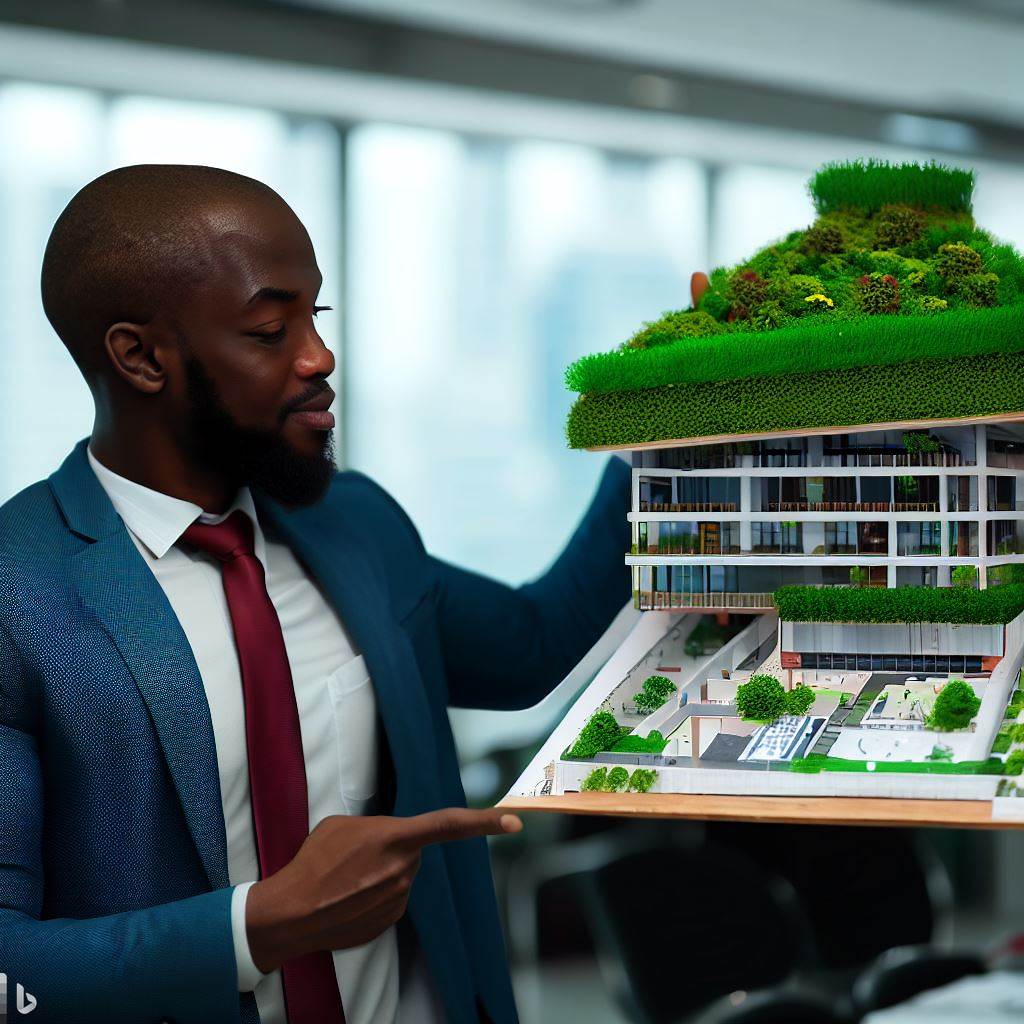Introduction
Technology is rapidly transforming every industry, and the architecture profession in Nigeria is no exception.
The adoption of technology, such as Building Information Modeling (BIM) software, virtual and augmented reality, and drones, has impacts on the architectural processes and practices in Nigeria.
The architecture profession in Nigeria has experienced an influx of architects that are tech-savvy, and this has led to architects leveraging technology to improve project efficiency, cost reduction, and sustainability.
The adoption of technology has also led to collaboration among architects, engineers, and contractors, improving project communication and coordination.
The importance of leveraging technology in Nigeria’s architecture profession cannot be overstated. It has the potential to revolutionize the industry by making it more efficient, cost-effective, and sustainable.
The use of technology will also make it easier for architects to integrate environmental and sustainability features into their designs, ensuring that Nigeria’s built environment is eco-friendlier.
Read: Architectural Regulations and Policies in Nigeria Explored
Overview of the Architecture Profession in Nigeria
Definition of the architecture profession
The architecture profession involves the design, planning, and construction of physical structures, including buildings, bridges, and parks.
Historical overview of architecture in Nigeria
Architecture in Nigeria has its roots in traditional African architecture, which is characterized by the use of local materials and styles.
However, with the influence of Western education and colonialism, Nigerian architecture adopted Western styles, such as Art Deco and Modernism.
Current status of the architecture profession in Nigeria
The architecture profession has grown in Nigeria over the years, with the establishment of architectural schools and the formation of the Nigerian Institute of Architects.
There are numerous architectural firms in the country, and many architects are involved in the construction of public and private structures.
Challenges facing the architecture profession in Nigeria
One of the major challenges facing the architecture profession in Nigeria is the lack of access to technology. Many architectural firms in Nigeria do not have the necessary software and hardware to create and present sophisticated designs.
Another challenge is the lack of government support and policies that promote the growth of the architecture profession.
Nigerian architects often have to compete against foreign firms for contracts, which can be a disadvantage when it comes to pricing and resources.
Additionally, there is a shortage of qualified architects in Nigeria. Many trained professionals opt to work outside the country, where there are better job opportunities.
Leveraging Tech in Nigeria’s Architecture Profession
The use of technology has the potential to transform the architecture profession in Nigeria. By leveraging tech, architects can overcome many of the challenges they face and take advantage of new opportunities.
Benefits of leveraging tech in the architecture profession
One of the benefits of using tech in the architecture profession is the ability to create detailed and sophisticated designs.
With the right software and hardware, architects can create 3D models, visualize their designs in real-time, and produce accurate and detailed drawings.
Using tech can also improve communication and collaboration between architects, clients, and contractors.
With online tools and platforms, architects can share their designs and ideas with others in real-time, making it easier to work together and make changes.
Tech solutions for the architecture profession in Nigeria
To leverage tech in the architecture profession, Nigerian architects can adopt various solutions, such as:
- BIM software: Building Information Modeling (BIM) software allows architects to create digital 3D models that contain all the information needed to design and construct a building.
BIM software can help architects produce detailed plans, estimate costs, and identify potential problems before construction begins. - Virtual reality (VR) and augmented reality (AR): VR and AR technology allow architects to visualize their designs in a fully immersive environment.
This can help clients better understand how the final product will look and feel, and can help architects identify potential design issues before construction begins. - Cloud-based collaboration tools: Cloud-based collaboration tools, such as Google Drive and Dropbox, can help architects work together and share their designs with others in real-time.
This can help ensure that everyone involved in a project is on the same page and can help prevent mistakes and misunderstandings.
Impacts of tech on the architecture profession in Nigeria
The adoption of tech solutions in the architecture profession in Nigeria can have several impacts, including:
- Increased efficiency and productivity: With tech solutions, architects can produce designs faster and with greater accuracy, reducing the time and resources needed for each project.
- Improved quality of design: Using sophisticated software and hardware can help architects produce more detailed and sophisticated designs, leading to higher-quality buildings and structures.
- Increased competitiveness: By adopting tech solutions, Nigerian architects can compete more effectively with foreign firms for contracts, providing better pricing and a higher level of service.
In essence, leveraging technology in the architecture profession in Nigeria can have significant benefits, from improving the quality of design to increasing efficiency and competitiveness.
While there are challenges to overcome, adopting tech solutions can help overcome these challenges and position Nigerian architects for success.
Read: Post-Modernism and Its Influence on Nigerian Architecture
The Role of Technology in Architecture
Technology is transforming industries across the globe, and architecture is not left behind. The application of technology has played a significant role in the development of architecture over the years.
Let’s discuss the meaning of technology, its importance in architecture, and the benefits of leveraging technology in the architecture profession, as well as examples of technology applications in architecture.
Definition of Technology
Technology refers to the use of scientific knowledge, tools, and techniques to solve problems and simplify complex tasks.
In architecture, technology covers a wide range of applications, including the use of computer-aided design (CAD) software, building information modeling (BIM) systems, 3D printing, virtual reality (VR), and many more.
Importance of Technology in Architecture
The application of technology in architecture has become an essential aspect of the profession. Architects can save time, reduce errors, and enhance productivity with the use of technology.
Technology also offers a more detailed and accurate approach to design, making it easier to bring ideas to reality.
Architects can collaborate more efficiently with other team members, whether they are in the same location or not.
Benefits of Leveraging Technology in the Architecture Profession
- Cost Savings: The use of technology can lead to significant cost savings in architecture. For example, the use of BIM and CAD software can help architects identify design errors before construction begins, thus reducing material waste and minimize construction costs.
- Improved Communication: Technology has made communication between architecture professionals more efficient. With tools like virtual reality and teleconferencing, architects can collaborate with clients, contractors, and colleagues from different locations in real-time.
- Enhanced Design: With technology, architects can now produce more detailed and accurate designs, thereby reducing errors, enhancing quality and ensuring that structures are built according to required specifications.
- Increased Productivity: The use of technology has enabled architects to get more done in less time. Automated software and tools, such as BIM, have streamlined many processes and facilitated faster workflows, ultimately increasing efficiency and productivity.
Examples of Technology Applications in Architecture
- Building Information Modeling (BIM): This is a software application used to create 3D models of buildings. BIM offers architects a comprehensive view of their project, from the design phase through to construction and maintenance.
- Computer-Aided Design (CAD): CAD is used to produce technical drawings and models of buildings. Architects can use these models to study designs, identify potential problems, and ensure that structures meet safety requirements.
- Augmented Reality (AR) and Virtual Reality (VR): These tools allow architects to create immersive 3D environments that help clients and stakeholders visualize the final project. AR and VR can also be used by architects for training and presentations.
- Remote collaboration tools: The COVID-19 pandemic has accelerated the need for remote collaboration tools, such as Microsoft Teams, Zoom, and Google Meet. These tools enable architecture teams to work together remotely, regardless of their location.
- 3D Printing: This technology has revolutionized the way architects create models of their designs. With 3D printers, architects can create detailed physical models, which enable them to study their projects in greater detail.
In summary, technology has become an indispensable aspect of the architecture profession. Architects who embrace technology can benefit from enhanced productivity, improved communication, cost savings, and enhanced design.
There are numerous technology applications in architecture, with BIM, CAD, AR, and VR being some of the most notable examples.
As technology continues to evolve, architects must remain up-to-date with the latest tools and techniques to remain competitive in the industry.
Read: The Intersection of Nigerian Culture and Architecture
You Might Also Like: The Influence of Urban Planners on Nigeria’s Cityscape
Current Use of Technology in Nigeria’s Architecture Profession
Nigeria’s architecture profession is gradually catching up with the rest of the world in terms of technology adoption. Although it is still in its early stages, the current technology trends in the industry show a promising future.
Overview of Current Technology Trends in Nigeria’s Architecture Profession
The current technology trends in Nigeria’s architecture profession range from building information modeling (BIM), virtual reality (VR), 3D printing, project management software, and cloud-based technologies.
BIM is a digital representation of the physical and functional properties of a building. It allows architects to collaborate effectively with other professionals by reducing communication errors, improving efficiency, and reducing construction costs.
VR, on the other hand, allows architects to create a virtual model of a building that can be experienced by a client in real-time. This technology helps architects to convey their design concepts to clients more effectively.
3D printing is also gaining popularity in Nigeria’s architecture profession. With this technology, architects can create complex models at a cheaper cost with higher accuracy and less waste.
Project management software helps architects to manage their projects more efficiently. They can track timelines, budgets, resources, and tasks in real-time, allowing them to make informed decisions regarding their projects.
Cloud-based technologies such as Dropbox, Google Drive, and OneDrive provide architects with remote access to project data, enabling them to work from anywhere in the world.
Examples of Architecture Firms in Nigeria That Leverage Technology
Several architecture firms in Nigeria are already leveraging technology to improve their operations. These firms understand the need to embrace technology to stay relevant and competitive in the global market.
Buildmek Design Studio is an architecture firm that is using BIM technology to improve efficiency and reduce construction costs.
They recently completed a project in Lagos that involved the renovation of an old building into a contemporary space. BIM technology helped them to detect and avoid any potential clashes before construction began.
Ahmed Masha Architecture is another architecture firm in Nigeria that is embracing technology.
They use VR technology to create a virtual model of their designs, allowing clients to experience their projects before construction begins. This technology has helped them to win more projects and create more value for their clients.
Other architecture firms in Nigeria that are leveraging technology include Spacefinish, Chronos Studeos, and Straata. These firms are at the forefront of the technology adoption in the industry and have positioned themselves for growth and success in the future.
Read: Dissecting The Architect Registration Council of Nigeria
Challenges Facing the Adoption of Technology in the Architecture Profession in Nigeria
The adoption of technology in Nigeria’s architecture profession is not without its challenges. Some architects are resistant to change and may prefer to stick to traditional methods of designing and construction.
There is also a lack of trained personnel who can effectively use the technology. This makes it challenging for architecture firms to fully integrate technology into their operations.
The cost of technology is also a significant barrier to adoption. Some architecture firms may not have the financial resources to acquire the necessary software and hardware to fully leverage the benefits of technology.
The inadequate power supply in Nigeria is another obstacle to technology adoption.
Frequent power outages and fluctuations in electricity supply can damage hardware and cause data loss, making it difficult for architecture firms to operate efficiently.
Therefore, the adoption of technology in Nigeria’s architecture profession is gradually gaining momentum.
It is essential for architecture firms to embrace these technological trends to stay competitive in the global market and improve their operations.
Although there are challenges to technology adoption, there are also opportunities for innovation, growth, and success in the industry.

Barriers and Challenges Facing the Adoption of Technology in Nigeria’s Architecture Profession
The architecture profession in Nigeria has initially been slow in adapting and integrating technology into the industry.
The absence of technology in the industry has affected the country’s architecture and construction industry negatively.
Let’s explore the barriers and challenges Nigeria’s architecture profession faces in the adoption of technology.
Barriers to the Adoption of Technology
- Limited Access to Technology: In Nigeria, factors like high import tariffs, limited access to the internet, high cost for tech infrastructures, and a lack of power supply halt the development of the technology industry.
- Limited Awareness: Many architects in Nigeria lack awareness of the benefits associated with integrating technology into the practice. This lack of awareness limits the evolution of the adoption of technology in the industry.
- Lack of Skilled Professionals: The architecture industry in Nigeria lacks professionals with adequate technical skills and expertise in technology. This shortage of professionals proficient in technology limits the integration of technology in the practice.
Challenges that Inhibit the Full Benefit of Technology in the Architecture Profession
- Resistance to Change: In Nigeria, some architects are resistant to change, and so, they resist the adoption of technology in the industry. This attitude hinders the development of the industry and affects productivity and efficiency.
- Lack of Standards: In Nigeria, there are no industry standards or regulations that mandate architects to integrate technology into their practices. This lack of standards contributes to the weak adoption of technology in the industry.
- Substandard Infrastructure: Informal settlements, poor urban planning, and a lack of infrastructural facilities contribute to the weak adoption of technology in Nigeria’s architecture profession.
Solutions to Address the Challenges Facing the Adoption of Technology in Nigeria’s Architecture Profession
- Partnering with the Government: Architects can partner with the government to increase awareness of the benefits of integrating technology into architecture practices. Enabling policies can be put in place to reduce the challenges of infrastructural development and increase access to technology.
- Training and Development: Architects can be trained to acquire and develop technical skills and expertise in technology. This solution will increase awareness and encourage adoption.
- standardization: It is essential to develop industry standards that enforce the use of technology. Standardization will encourage adoption and drive accountability within the industry.
The adoption of technology will open doors of opportunities for architects in Nigeria. Emerging technologies like Building Information Modelling (BIM) will enhance the industry workflow.
It is crucial for the architecture profession in Nigeria to explore and embrace the use and integration of technology in practice.
Read: How Nigerian Architecture Responds to Climate Change
Conclusion
As seen in this article, technology has a crucial role to play in Nigeria’s architecture profession. Through the use of cutting-edge software, architects can streamline their work and improve efficiency.
This can ultimately lead to better designs that meet clients’ needs while also being sustainable and environmentally friendly.
While technology cannot replace the creativity and vision of architects, it can certainly enhance their work. Therefore, it is essential for architects in Nigeria to embrace technology and continuously update their skills to stay competitive in the industry.
As a final thought, we recommend that architects take advantage of the many tech tools available to them, including CAD programs, BIM software, and 3D printing.
This can help them create more innovative designs and save time on manual tasks. In addition, we urge architects to consider the benefits of green technology and sustainable materials when designing buildings.
Finally, we call on all architects in Nigeria to stay up to date with the latest tech trends and seek out opportunities to learn from experts in the field.
By doing so, they can stay ahead of the competition and contribute to the development of Nigeria’s growing architecture sector.




